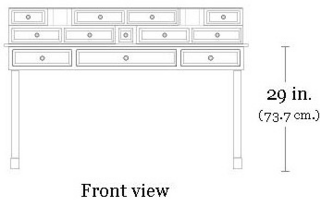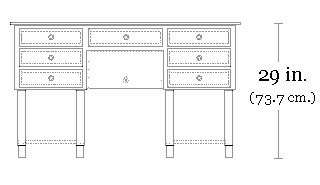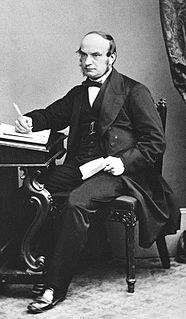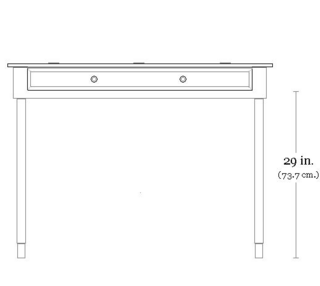
A tambour desk is a desk with desktop-based drawers and pigeonholes, in a way resembling bureau à gradin. The small drawers and nooks are covered, when required, by reeded or slatted shutters, tambours, which usually retract in the two sides, left and right. It is a flatter and "sideways" version of the rolltop desk.

A desk or bureau is a piece of furniture with a flat table-style work surface used in a school, office, home or the like for academic, professional or domestic activities such as reading, writing, or using equipment such as a computer. Desks often have one or more drawers, compartments, or pigeonholes to store items such as office supplies and papers. Desks are usually made of wood or metal, although materials such as glass are sometimes seen.

A drawer is a box-shaped container that fits into a piece of furniture in such a way that it can be drawn out horizontally to reach its contents. Drawers are built into numerous types of furniture, including cabinets, chests of drawers (bureaus) and the like.

A bureau à gradin is an antique desk form resembling a writing table with, in addition, one or several tiers of small drawers and pigeonholes built on part of the desktop surface. Usually the drawers and pigeonholes directly face the user, but they can also surround three sides of the desk, as is the case for the Carlton house desk form. A small, portable version is a bonheur du jour.
Unlike the rolltop desk, the tambour desk uses straight, perfectly vertical rows of shutters, and the work surface rests on a few drawers, which in turn are supported by short legs instead of pedestals. In addition, half of the desktop folds back on itself when not in use. The desktop is supported by sliders, like a secretary desk or a slant top desk when it is unfolded.

A rolltop desk is a 19th-century reworking of the pedestal desk with, in addition, a series of stacked compartments, shelves, drawers and nooks in front of the user, much like the bureau à gradin or the Carlton House desk. In contrast to these the compartments and the desktop surface of a rolltop desk can be covered by means of a tambour consisting of linked wooden slats that roll or slide through slots in the raised sides of the desk. In that, it is a descendant in function, and partly in form, of the cylinder desk of the 18th century. It is a relative of the tambour desk whose slats retract horizontally rather than vertically.
A secretary desk or escritoire is made of a base of wide drawers topped by a desk with a hinged desktop surface, which is in turn topped by a bookcase usually closed with a pair of doors, often made of glass. The whole is usually a single, tall and heavy piece of furniture.

The slant top desk can be considered in some ways as the ancestor or the little brother of the secretary desk for it is, for all practical purposes, a secretary desk without the massive bookcase on top of it. It can also be considered as the descendant, in form, of the desk on a frame, which was a form of portable desk in earlier eras.
The tambour desk is an antique form indigenous to the United States of America and should not be confused with the British tambour writing table.

A true antique is an item perceived as having value because of its aesthetic or historical significance, and often defined as at least 100 years old, although the term is often used loosely to describe any object that is old. An antique is usually an item that is collected or desirable because of its age, beauty, rarity, condition, utility, personal emotional connection, and/or other unique features. It is an object that represents a previous era or time period in human history. Vintage and collectible are used to describe items that are old, but do not meet the 100-year criteria.

The United States of America (USA), commonly known as the United States or America, is a country composed of 50 states, a federal district, five major self-governing territories, and various possessions. At 3.8 million square miles, the United States is the world's third or fourth largest country by total area and is slightly smaller than the entire continent of Europe's 3.9 million square miles. With a population of over 327 million people, the U.S. is the third most populous country. The capital is Washington, D.C., and the largest city by population is New York. Forty-eight states and the capital's federal district are contiguous in North America between Canada and Mexico. The State of Alaska is in the northwest corner of North America, bordered by Canada to the east and across the Bering Strait from Russia to the west. The State of Hawaii is an archipelago in the mid-Pacific Ocean. The U.S. territories are scattered about the Pacific Ocean and the Caribbean Sea, stretching across nine official time zones. The extremely diverse geography, climate, and wildlife of the United States make it one of the world's 17 megadiverse countries.

The United Kingdom, officially the United Kingdom of Great Britain and Northern Ireland but more commonly known as the UK or Britain, is a sovereign country lying off the north-western coast of the European mainland. The United Kingdom includes the island of Great Britain, the north-eastern part of the island of Ireland and many smaller islands. Northern Ireland is the only part of the United Kingdom that shares a land border with another sovereign state—the Republic of Ireland. Apart from this land border, the United Kingdom is surrounded by the Atlantic Ocean, with the North Sea to the east, the English Channel to the south and the Celtic Sea to the south-west, giving it the 12th-longest coastline in the world. The Irish Sea lies between Great Britain and Ireland. With an area of 242,500 square kilometres (93,600 sq mi), the United Kingdom is the 78th-largest sovereign state in the world. It is also the 22nd-most populous country, with an estimated 66.0 million inhabitants in 2017.






